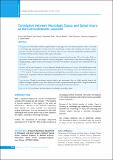Please use this identifier to cite or link to this item:
https://hdl.handle.net/20.500.14356/1020Full metadata record
| DC Field | Value | Language |
|---|---|---|
| dc.contributor.author | Dhakal, Gaurav Raj | - |
| dc.contributor.author | Sadiqi, Said | - |
| dc.contributor.author | Shah, Gyanendra | - |
| dc.contributor.author | Shrestha, Sushil | - |
| dc.contributor.author | Paudel, Santosh | - |
| dc.contributor.author | Kawaguchi, Yoshiharu | - |
| dc.contributor.author | Riew, K.Daniel | - |
| dc.date.accessioned | 2023-04-20T06:01:35Z | - |
| dc.date.available | 2023-04-20T06:01:35Z | - |
| dc.date.issued | 2022 | - |
| dc.identifier.citation | DhakalG. R., SadiqiS., ShahG., ShresthaS., PaudelS., KawaguchiY., & RiewK. (2022). Correlation between neurologic status and spinal injury at the Cervicothoracic Junction. Journal of Nepal Health Research Council, 20(01), 124-130. https://doi.org/10.33314/jnhrc.v20i01.4007 | en_US |
| dc.identifier.issn | Print ISSN: 1727-5482; Online ISSN: 1999-6217 | - |
| dc.identifier.uri | http://103.69.126.140:8080/handle/20.500.14356/1020 | - |
| dc.description | Original Article | en_US |
| dc.description.abstract | Abstract Background: With limited studies on spinal injuries occurring at the cervicothoracic junction, there is currently a knowledge gap regarding the correlation between morphology of injury and neurology and whether surgery provides a favorable neurological outcome. The primary objective was to determine whether the neurological deficit correlated with the severity of injury at this region of the spine. Methods: All patients with injuries at the cervicothoracic junction from December 2015 to December 2020 in a government trauma hospital were included. Patient demographics, characteristics of the injury, neurological score, imaging findings, surgery details and neurological outcomes were analyzed. All patients had a minimum follow up of 2 years. Results: Of the total 30 patients, 23 were male and 7 female with mean age 42.4 years. 90% had fall injuries with 76.7% sustaining AO type C injury and 10% with AO B2 injury.73.4% had injury at C6-C7 level followed by 13.3% , C7-T1. Only 16.7% patients presented with intact neurology. Plain x-rays failed to detect cervicothoracic junction, injuries in 63.3% patients. Posterior stabilization was performed in 56.7%. Neurological improvement was observed in 9 patients. Conclusions: Though cervicothoracic junction injuries are uncommon, they are highly unstable injuries and difficult to diagnose by plain x-rays. These injuries also result in profound neurological deficit. Surgical stabilization of these injuries should be considered for a favorable neurological and functional outcome. Keywords: Cervico-thoracic junction; injuries; morphology; neurology; spine. | en_US |
| dc.language.iso | en | en_US |
| dc.publisher | Nepal Health Research Council | en_US |
| dc.relation.ispartofseries | Jan-March, 2022;4007 | - |
| dc.subject | Cervico-thoracic junction | en_US |
| dc.subject | injuries | en_US |
| dc.subject | morphology | en_US |
| dc.subject | neurology | en_US |
| dc.subject | spine | en_US |
| dc.title | Correlation between neurologic status and spinal injury at the Cervicothoracic Junction | en_US |
| dc.type | Journal Article | en_US |
| local.journal.category | Original Article | - |
| Appears in Collections: | Vol. 20 No. 01 (2022): Issue 54 Jan-March, 2022 | |
Files in This Item:
| File | Description | Size | Format | |
|---|---|---|---|---|
| 4007-Manuscript-27878-1-10-20220606.pdf | Fulltext Download | 222.75 kB | Adobe PDF |  View/Open |
Items in DSpace are protected by copyright, with all rights reserved, unless otherwise indicated.
